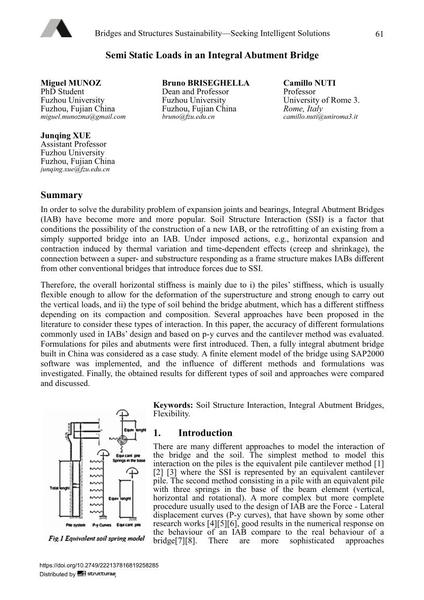Semi Static Loads in an Integral Abutment Bridge

|
|
|||||||||||
Détails bibliographiques
| Auteur(s): |
Miguel Munoz
Junqing Xue Bruno Briseghella Camillo Nuti |
||||
|---|---|---|---|---|---|
| Médium: | papier de conférence | ||||
| Langue(s): | anglais | ||||
| Conférence: | IABSE Conference: Bridges and Structures Sustainability - Seeking Intelligent Solutions, Guangzhou, China, 8-11 May 2016 | ||||
| Publié dans: | IABSE Conference, Guangzhou, China, 8 – 11 May 2016 | ||||
|
|||||
| Page(s): | 61-69 | ||||
| Nombre total de pages (du PDF): | 9 | ||||
| Année: | 2016 | ||||
| DOI: | 10.2749/222137816819258285 | ||||
| Abstrait: |
In order to solve the durability problem of expansion joints and bearings, Integral Abutment Bridges (IAB) have become more and more popular. Soil Structure Interaction (SSI) is a factor that conditions the possibility of the construction of a new IAB, or the retrofitting of an existing from a simply supported bridge into an IAB. Under imposed actions, e.g., horizontal expansion and contraction induced by thermal variation and time-dependent effects (creep and shrinkage), the connection between a super- and substructure responding as a frame structure makes IABs different from other conventional bridges that introduce forces due to SSI. Therefore, the overall horizontal stiffness is mainly due to i) the piles’ stiffness, which is usually flexible enough to allow for the deformation of the superstructure and strong enough to carry out the vertical loads, and ii) the type of soil behind the bridge abutment, which has a different stiffness depending on its compaction and composition. Several approaches have been proposed in the literature to consider these types of interaction. In this paper, the accuracy of different formulations commonly used in IABs’ design and based on p-y curves and the cantilever method was evaluated. Formulations for piles and abutments were first introduced. Then, a fully integral abutment bridge built in China was considered as a case study. A finite element model of the bridge using SAP2000 software was implemented, and the influence of different methods and formulations was investigated. Finally, the obtained results for different types of soil and approaches were compared and discussed. |
||||
